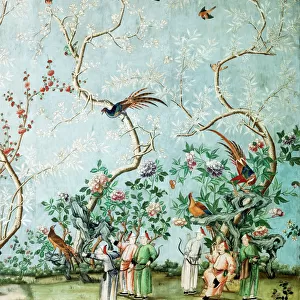Home > Europe > United Kingdom > England > Cleveland
Emperor Yao Visiting Yu Chonghua, mid- to late 1600s. Creator: Kusumi Morikage (Japanese, c
![]()

Wall Art and Photo Gifts from Heritage Images
Emperor Yao Visiting Yu Chonghua, mid- to late 1600s. Creator: Kusumi Morikage (Japanese, c
Emperor Yao Visiting Yu Chonghua, mid- to late 1600s. One of a pair, this screen shows a section of the narrative of how the Chinese Emperor Yao (about 2356-2255 BC) selected his successor, Yu Chonghua (about 2294- 2184 BC), who would become Emperor Shun. The artist who painted this screen, Kusumi Morikage, trained with Kano Tan yo (1602-1647), painter-in-residence to Japans shogun, the countrys ruler, and was one of his four top students. Despite the conservative subject matter, Morikages distinctive sensibility shines through in his playful treatment of the gray and white elephants in the far left panel of the composition. According to legend, Chonghua was so virtuous that in the spring, elephants bounded down from the mountains to help him till the soil with their tusks
Heritage Images features heritage image collections
Media ID 19619245
© Heritage Art/Heritage Images
1615 1868 And Gold On Paper 1690
FEATURES IN THESE COLLECTIONS
> Europe
> United Kingdom
> England
> Cleveland
> Transportation
> Trains
Emperor Yao Visiting Yu Chonghua, mid- to late 1600s - A Captivating Tale of Virtue and Succession
EDITORS COMMENTS
. This print captures a section of the narrative depicting Emperor Yao's visit to Yu Chonghua, an event that would shape the future of Chinese history. Painted by Kusumi Morikage, a talented artist who trained under Kano Tan yo, this screen showcases his unique artistic sensibility. The composition portrays the legendary tale of how Emperor Yao selected his successor, Yu Chonghua, who later became Emperor Shun. Despite its conservative subject matter, Morikage infuses playful elements into the artwork. Notably, in the far left panel stands a group of gray and white elephants whose presence adds whimsy to the scene. According to legend, these elephants symbolize Chonghua's virtuous nature. In springtime, they would descend from the mountains and assist him in tilling the soil with their mighty tusks—a testament to his righteousness and connection with nature. Created during Japan's Edo period (1615-1868), this gold-on-paper masterpiece is part of a pair of six-panel folding screens held at The Cleveland Museum of Art. It exemplifies Morikage's skillful brushwork and attention to detail while narrating an ancient story that continues to captivate audiences today. Through this exquisite artwork by Heritage Art/Heritage Images, we are transported back in time—immersing ourselves in a world where virtue leads to greatness and where even elephants lend their strength for noble causes.
MADE IN AUSTRALIA
Safe Shipping with 30 Day Money Back Guarantee
FREE PERSONALISATION*
We are proud to offer a range of customisation features including Personalised Captions, Color Filters and Picture Zoom Tools
SECURE PAYMENTS
We happily accept a wide range of payment options so you can pay for the things you need in the way that is most convenient for you
* Options may vary by product and licensing agreement. Zoomed Pictures can be adjusted in the Cart.













